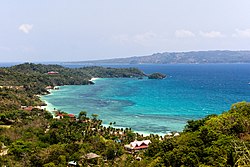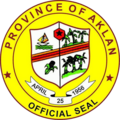Aklan Akean (Aklanon) | |
|---|---|
(from top: left to right) Boracay, Kalibo Cathedral, Ati-Atihan Festival, Bakhawan Ecopark, Lezo Church, and Aklan Provincial Capitol | |
| Motto: "Arangkada, Aklan" | |
| Anthem: "Aklan Hymn" | |
 Location in the Philippines | |
| Coordinates: 11°40′N122°20′E / 11.67°N 122.33°E | |
| Country | Philippines |
| Region | Western Visayas |
| First settled | 13th century |
| Founded | 25 April 1956 |
| Capital and largest municipality | Kalibo |
| Government | |
| • Governor | Jose Enrique M. Miraflores (Lakas) |
| • Vice Governor | Dexter M. Calizo (Lakas) |
| • Legislature | Aklan Provincial Board |
| Area | |
• Total | 1,821.42 km2 (703.25 sq mi) |
| • Rank | 64th out of 81 |
| Highest elevation | 1,777 m (5,830 ft) |
| Population (2024 census) [2] | |
• Total | 634,422 |
| • Rank | 51st out of 81 |
| • Density | 348.312/km2 (902.123/sq mi) |
| • Rank | 23rd out of 81 |
| Demonym | Aklanon |
| Divisions | |
| • Independent cities | 0 |
| • Component cities | 0 |
| • Municipalities | |
| • Barangays | 327 |
| • Districts | Legislative districts of Aklan |
| Time zone | UTC+8 (PHT) |
| IDD : area code | +63 (0)36 |
| ISO 3166 code | PH-AKL |
| HDI | |
| HDI rank | 29th in Philippines (2019) |
| Spoken languages | |
| GDP (2022) | ₱63.57 billion $1.084 billion [3] |
| Growth rate | |
| Website | aklan |
Aklan, officially the Province of Aklan, [a] is a province in the Western Visayas region of the Philippines. Its capital and largest town is Kalibo. The province is situated in the northwest portion of Panay Island, bordering Antique to the southwest, and Capiz to the southeast. Aklan faces the Sibuyan Sea and Romblon province to the north.
Contents
- History
- Early history
- Spanish colonial era
- Japanese occupation
- Postwar Era
- Marcos dictatorship era
- Contemporary history
- Geography
- Administrative divisions
- Demographics
- Ethnic groups
- Languages
- Religion
- Economy
- Agriculture
- Aquaculture
- Industry
- Government
- Transportation
- Road
- Airports
- Seaports
- Culture
- Cuisine
- Festivals
- Literature
- Universities and colleges
- Flora and Fauna
- Notable personalities
- See also
- Notes
- References
- External links
Aklan is most well-known for Boracay, a resort island 0.8 kilometers north of the tip of Panay. It is known for its white sand beaches and is considered one of the more prominent destinations in the country. The Ati-Atihan Festival of Kalibo has also been known worldwide, hence declared "The Mother of all Philippine Festivals." It is an annual celebration held on the third Sunday of January to honor the Santo Niño (Infant Jesus). The festival showcases tribal dancing through the town's main streets to the tune of ethnic music, with participants in indigenous costumes and gear. [4]
















